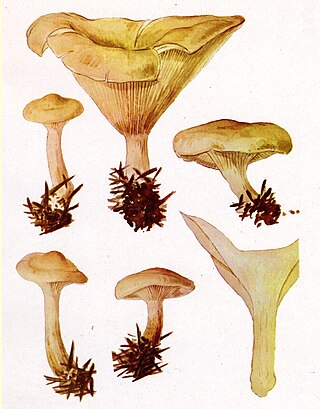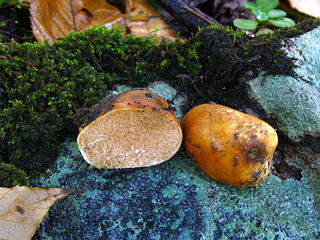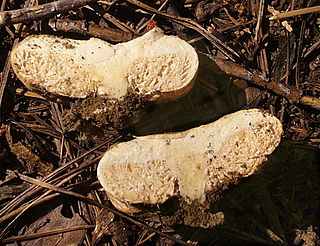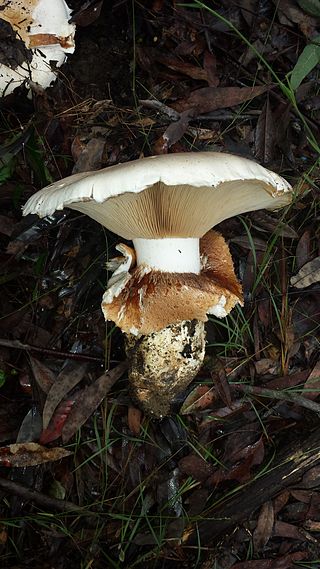
Paralepistopsis amoenolens is an agaric fungus in the Tricholomataceae family. It is commonly known as the paralysis funnel.

Gautieria is a genus of hypogeal fungi in the family Gomphaceae. They form mycorrhizae with various tree species, mostly from the family Pinaceae. Species are present over much of the world's temperate and boreal forest habitats. It is well documented that species from this genera are an important part of the diet of the northern flying squirrel. Also, some Australian marsupials, especially the rat-kangaroos, feed extensively on these fungi. The fungi also benefit from this relationship: not only do the squirrels help to disperse the spores and propagate the species, studies suggest that passage through the digestive tract of a mammal promotes germination of spores.
Strossmayeria is a genus of fungi in the family Helotiaceae. The genus contains 16 species. The genus was circumscribed by Stephan Schulzer von Müggenburg in Oesterr. Bot. Z. vol.31 on page 314 in 1881.
Gigasperma is an inactive genus of fungi in the order Agaricales with a single species. It was treated either as the only genus in the monotypic family Gigaspermataceae, or part of the wider Cortinariaceae. Gigasperma was circumscribed by Austrian mycologist Egon Horak in 1971.

Descolea is a genus of fungi in the family Bolbitiaceae. Described by mycologist Rolf Singer in 1952, the widespread genus contains about 15 species. It was formerly placed in the family Cortinariaceae because of its limoniform basidiospores and its ectomycorrhizal lifestyle. A 2013 molecular phylogenetics study by Tóth et al. found it to be closely related to the genus Pholiotina The genus Pseudodescolea, erected for the single Descolea-like species Pseudodescolea lepiotiformis, was formerly considered distinct until a 1990 study found it to be a synonym of Descolea antarctica.

Rimbachia is a genus of fungi in the family Tricholomataceae. The genus contains about ten species with a widespread distribution in tropical regions.
Lenzitopsis is a genus of fungi in the family Thelephoraceae. This genus contains two species, the type Lenzitopsis oxycedri and L. daii, described as new to science in 2012.

Zelleromyces is a genus of fungi in the family Russulaceae. It was first described by mycologists Rolf Singer and Alexander H. Smith in 1960 to contain hypogeous (underground) fungi with gasteroid fruit bodies that "bleed" latex when they are cut.
Wrightoporia is a genus of fungi in the family Bondarzewiaceae. According to a 2008 estimate, the widely distributed genus contains 23 species. The genus was circumscribed by Zdeněk Pouzar in Ceská Mykol. vol.20 on page 173 in 1966.

František Kotlaba was a Czech botanist and mycologist.
Mackintoshia is a fungal genus in the family Boletaceae. It was originally placed in Cortinariaceae. The genus is monotypic, containing the single truffle-like species Mackintoshia persica, found in Zimbabwe. This fungus, eaten by both the common duiker and the Karanga people, is little known outside the Midlands Province of Zimbabwe. Mackintoshia was circumscribed by Giovanni Pacioni and Cathy Sharp in 2000. The genus name honors British-Rhodesian farmer Robbie Mackintosh, who collected and documented some early specimens. The specific epithet persica is Latin for peach, referring to its odor.
Stephanopus is a genus of fungi in the family Cortinariaceae. The genus, circumscribed by mycologists Meinhard Moser and Egon Horak in 1975, contains five species found in South America.

Octaviania is a genus of truffle-like fungi in the family Boletaceae. The widespread genus is estimated to contain 15 species.

Arcangeliella is a genus of gasteroid fungi in the family Russulaceae. Taxonomic and phylogenetic research has shown that it is very likely a synonym of Lactarius. The type species Arcangeliella borziana was moved to Lactarius in 2003. However, the genus name is still in use for several species for which new combinations have not yet been proposed.

Austrocortinarius australiensis, commonly known as the skirt webcap, is a species of mushroom in the family Cortinariaceae which is native to Australia and New Zealand. The white mushrooms appear in autumn and can grow very large, with their caps reaching 30 cm (12 in) in diameter.
Austrocortinarius is a genus of fungi in the family Cortinariaceae.
Volvanarius is a genus of fungi in the family Cortinariaceae.









